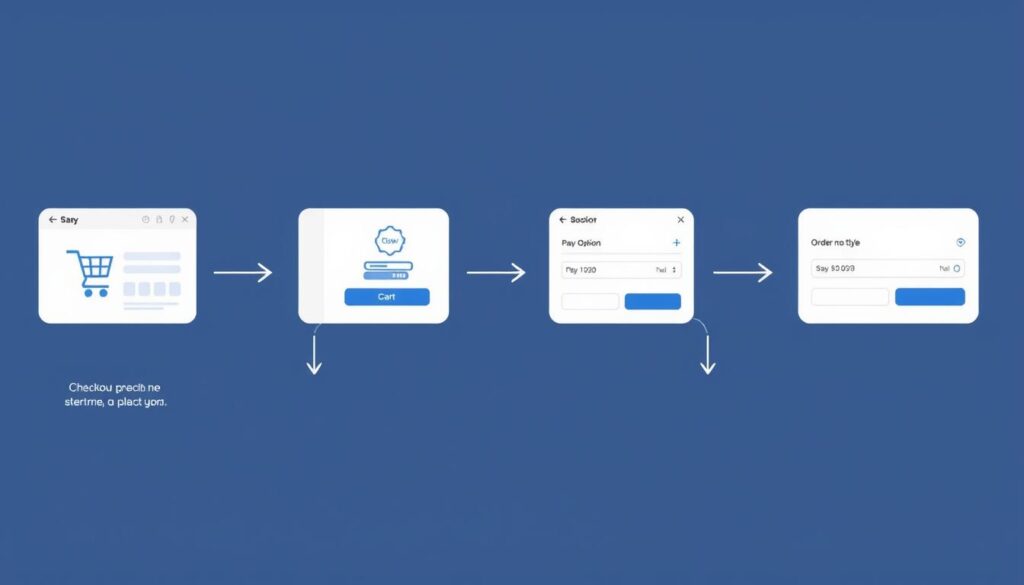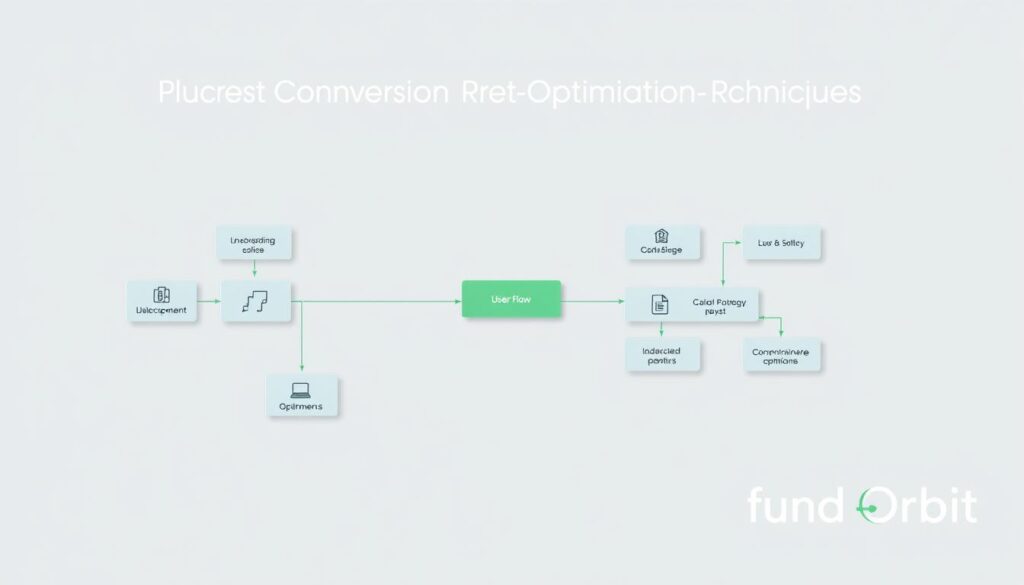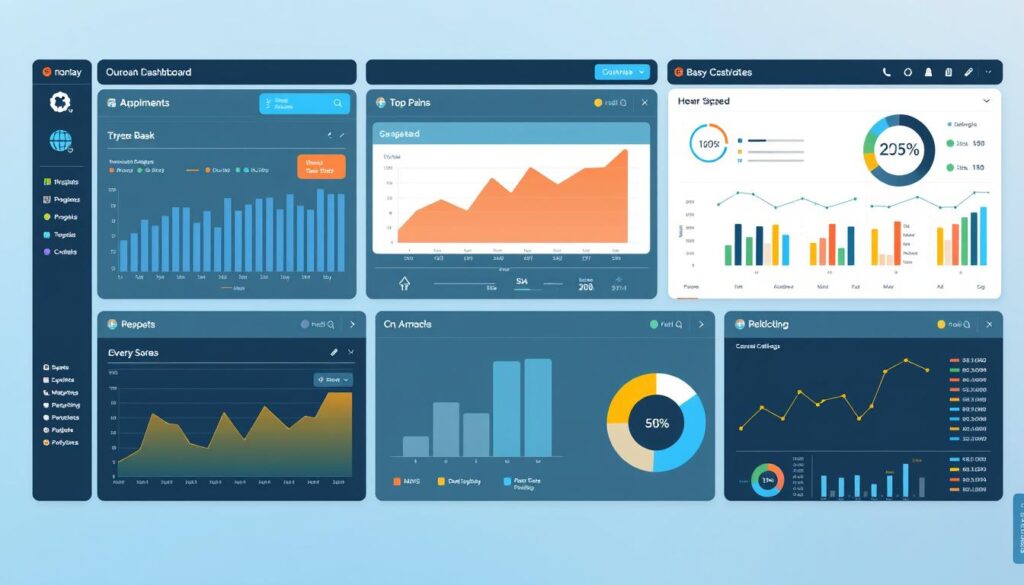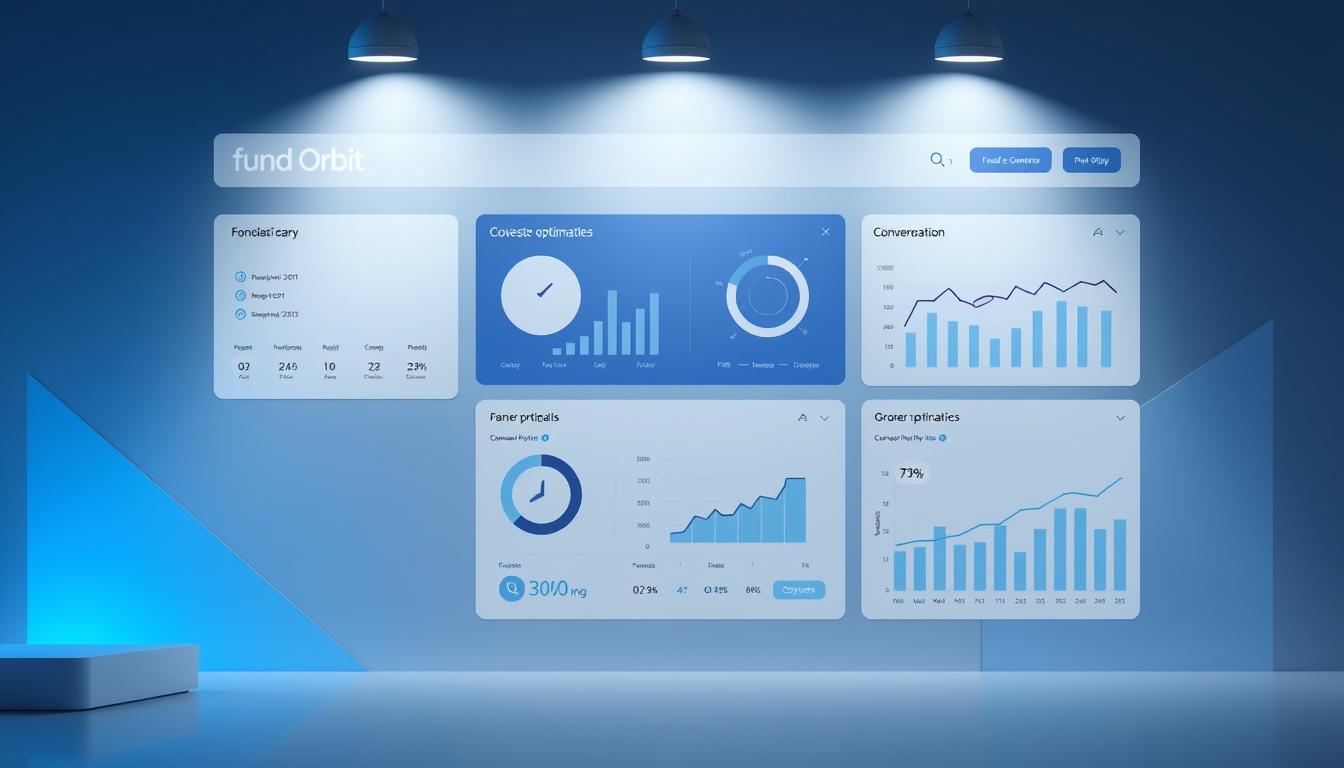Almost 90% of personalization efforts result in a positive ROI, highlighting the significance of tailored approaches in enhancing customer experiences and driving business growth.
At CoWrit Technologies Inc, we’ve seen firsthand how optimizing content can significantly impact campaign success. By focusing on conversion rate optimization and creating a seamless user experience, businesses can improve their overall performance.
Understanding the interconnected nature of UX, conversion rates, and mobile optimization is crucial for ecommerce success in today’s competitive digital marketplace.
Key Takeaways
- Personalization efforts can lead to a positive ROI.
- Optimizing content is crucial for campaign success.
- Conversion rate optimization enhances business performance.
- A seamless user experience is vital for ecommerce success.
- Understanding UX, conversion rates, and mobile optimization is key.
Understanding E-commerce Conversion Rates
E-commerce conversion rates are a crucial metric for online businesses, indicating the percentage of website visitors who complete a desired action, such as making a purchase.
To effectively optimize your e-commerce strategy, it’s essential to understand what conversion rates represent and how they’re calculated.
What Defines a Conversion in E-commerce
In e-commerce, a conversion occurs when a visitor completes a desired action, typically making a purchase. However, conversions can also include other actions like signing up for a newsletter or creating an account.
Conversion rates are calculated based on the number of conversions divided by the total number of visitors to your site.
How to Calculate Your Conversion Rate
To calculate your conversion rate, divide the number of conversions by the total number of visitors and multiply by 100. For example, if you had 100 conversions from 10,000 visitors, your conversion rate would be 1%.
Average ecommerce conversion rates are around 2.5-3%. A 3%-plus conversion rate should be the baseline goal for your online store.
Benchmarking: What’s a Good Conversion Rate?
A “good” conversion rate varies by industry and product category. For instance, some industries may have higher average conversion rates due to the nature of their products or services.
| Industry | Average Conversion Rate |
|---|---|
| Fashion | 1.5% – 3% |
| Electronics | 2% – 4% |
| Home Goods | 2.5% – 4.5% |
Understanding the average conversion rate for your specific industry helps in setting realistic goals. Benchmarking against competitors and industry leaders is also crucial for establishing meaningful targets for improvement.
The Business Impact of Conversion Rate Optimization
The impact of conversion rate optimization on business performance cannot be overstated. As e-commerce continues to grow, the importance of maximizing the effectiveness of online stores becomes increasingly critical.
Conversion rate optimization has several key benefits that directly impact the bottom line of businesses.
Lower Customer Acquisition Costs
By optimizing conversion rates, businesses can reduce their customer acquisition costs. This is because a higher conversion rate means that more visitors are completing the desired actions, thereby reducing the cost per acquisition. A lower cost per acquisition allows businesses to allocate more resources to other areas, such as marketing and product development.
Increased Revenue Without Additional Traffic
Improving conversion rates can lead to increased revenue without the need for additional traffic. This is achieved by making the most of the existing visitor base. For instance, a 1% increase in conversion rate can lead to a significant increase in revenue, as illustrated in the following table:
| Conversion Rate | Monthly Visitors | Conversions | Revenue (avg. order value $100) |
|---|---|---|---|
| 2% | 10,000 | 200 | $20,000 |
| 3% | 10,000 | 300 | $30,000 |
Competitive Advantage in the Digital Marketplace
Businesses with higher conversion rates can gain a competitive advantage in the market. This is because they are able to achieve more with their existing traffic, compared to competitors with lower conversion rates. A higher conversion rate can be a key differentiator, especially in crowded market segments. By leveraging conversion rate optimization, businesses can outperform their competitors and gain market share.

E-commerce Solutions: User Experience, Conversion Rate & Mobile Optimization
The key to e-commerce success lies in understanding the interconnected nature of user experience, conversion rate optimization, and mobile optimization. These three elements are not isolated; they work together to create a seamless and effective online shopping environment.
The Interconnected Nature of UX, CRO, and Mobile
User experience (UX) is the foundation upon which conversion rate optimization (CRO) and mobile optimization are built. A well-designed UX ensures that visitors can easily navigate and interact with your site, leading to higher conversion rates. Meanwhile, mobile optimization is critical as it directly impacts UX and CRO, given the increasing number of mobile shoppers.
Optimizing for mobile not only improves the user experience on smaller screens but also enhances overall site performance, contributing to better conversion rates.

Key Metrics That Matter Beyond Conversion Rate
Beyond conversion rates, several other metrics are crucial for understanding your e-commerce site’s performance. These include Bounce Rate, Exit Rate, Click-through Rate (CTR), Average Session Duration, and Average Page Depth. Monitoring these metrics provides a comprehensive view of user behavior and identifies areas for improvement.
Creating a Holistic Optimization Strategy
To create a holistic optimization strategy, we need to integrate UX, CRO, and mobile optimization efforts. This involves prioritizing optimization based on potential impact and implementation difficulty, creating a testing roadmap to address critical conversion barriers, and ensuring that individual efforts contribute to overall business goals.
By adopting a holistic approach, e-commerce businesses can maximize their optimization efforts, leading to improved user experience, higher conversion rates, and increased revenue.
Essential UX Elements That Drive Conversions
The success of an e-commerce platform hinges on its ability to provide a seamless and intuitive user experience. To achieve this, online retailers must focus on several key UX elements that directly influence conversion rates.
Intuitive Navigation and Site Structure
A well-organized site structure and intuitive navigation are critical for helping users find what they’re looking for quickly. This reduces friction and makes it more likely that visitors will complete a purchase. By implementing clear categorization, minimizing the number of clicks to reach product pages, and using a responsive design, e-commerce sites can significantly enhance the user experience.
High-Quality Product Images and Videos
High-quality product images and videos play a crucial role in e-commerce, as they allow customers to evaluate products more effectively. According to Baymard’s usability testing, 56% of users immediately begin exploring product images upon arriving on an e-commerce page. However, low-quality images or those that cannot be zoomed in on adequately can lead to high cart abandonment rates. In fact, Baymard’s benchmark showed that only 25% of e-commerce sites provide sufficient images for users to properly evaluate a product. Incorporating high-quality visuals can significantly improve the shopping experience and increase conversions.

Compelling Product Descriptions
Effective product descriptions are vital for driving conversions. They need to strike a balance between providing comprehensive information and being scannable. To achieve this, e-commerce businesses should structure their product descriptions to address both emotional and rational buying motivations. By highlighting the most important product features and benefits based on customer research, businesses can create compelling content that resonates with their target audience.
Some key strategies for crafting compelling product descriptions include:
- Using a format that is easy to scan, such as bullet points or short paragraphs.
- Focusing on the benefits and features that matter most to customers.
- Incorporating customer feedback and reviews to build trust and credibility.
- Using persuasive language that appeals to the customer’s emotional and rational motivations.
| Product Description Element | Best Practice | Impact on Conversion | Format | Use bullet points or short paragraphs | Improves scannability and readability |
|---|---|---|
| Content | Focus on customer benefits and features | Increases relevance and appeal |
| Language | Use persuasive and customer-centric language | Enhances emotional connection and trust |
Trust Signals: Building Confidence in Your E-commerce Store
Trust signals are essential elements that can make or break an e-commerce store’s ability to convert visitors into customers. In today’s digital marketplace, customers are more cautious than ever, and it’s our job to reassure them that their purchase is secure and that they can trust our brand.
Security Badges and SSL Certificates
Displaying security badges and having an SSL certificate is a fundamental trust signal. It assures customers that their data is protected and that our site is secure. An SSL certificate is not just a technical requirement; it’s a visual cue that we’re serious about security, directly influencing conversion rates.
Customer Reviews and Testimonials
Customers often look to others’ experiences when making a purchasing decision. By showcasing customer reviews and testimonials, we provide social proof that can significantly boost confidence in our brand. It’s essential to display these prominently on our site, especially on product pages.
Clear Return and Shipping Policies
A clear policy on returns and shipping is vital. A full 11% of buyers have abandoned orders because they weren’t happy with the return policy of the site. By making our policies transparent and easy to understand, we can reduce anxiety and encourage customers to complete their purchase. This includes displaying shipping costs and estimated delivery times clearly.
- Transparent policies around shipping and returns directly impact conversion rates.
- Creating and displaying shipping and return policies that build confidence is crucial.
- Optimal placement of policy information at key decision points in the purchase journey enhances customer trust.
Optimizing Your Checkout Process

The checkout process is a critical juncture in the customer’s journey, where a seamless experience can significantly boost conversion rates. A well-optimized checkout process reduces friction, making it easier for customers to complete their purchases.
Streamlining Form Fields and Input Requirements
Simplifying form fields is crucial for reducing cart abandonment. By minimizing the information required from the user, we can significantly enhance the checkout experience. This involves removing unnecessary fields and utilizing technologies like autofill to expedite the process.
For instance, implementing a single-page checkout can reduce the complexity and make the process more user-friendly. This approach has been shown to improve conversion rates by reducing the number of steps a customer must take to complete a purchase.
Guest Checkout vs. Account Creation
First off, it’s essential to ensure that a user has the option to check out as a guest. Being forced to create an account is a significant driver of order abandonment. Offering a guest checkout option can significantly reduce friction and increase the likelihood of completing a purchase.
By providing a clear and straightforward guest checkout process, businesses can cater to customers who prefer a quicker, more streamlined experience.
Payment Options and Security Reassurance
Offering multiple payment options has become essential for maximizing conversion rates across different customer segments. Understanding payment preferences across different demographics helps create a checkout experience that accommodates diverse customer needs.
We’ll explain why displaying payment options and security reassurances is crucial for building confidence at the critical moment of purchase decision. For example, displaying security badges and SSL certificates can significantly enhance trust.
By understanding the importance of payment flexibility and security, businesses can implement strategies to improve the checkout experience, thereby reducing cart abandonment and increasing conversions.
Mobile Optimization Strategies for E-commerce

As mobile commerce continues to grow, optimizing your e-commerce site for mobile users becomes increasingly crucial. By 2025, more than 10 percent of all retail sales in the United States is expected to be generated via mobile commerce — a growth of nearly 7% since 2018. If your e-commerce store does not provide a great mobile experience, you are missing out on a significant number of sales.
Responsive Design Best Practices
A responsive design is the foundation of a successful mobile e-commerce strategy. It ensures that your website adapts seamlessly to various screen sizes and devices, providing an optimal user experience. Key best practices include using flexible grids, images, and media queries to create a flexible and adaptable layout.
Mobile-Specific UX Considerations
When it comes to mobile UX, simplicity and ease of navigation are paramount. Ensure that your site’s navigation is intuitive, with clear calls-to-action and minimal clutter. Mobile users should be able to find what they’re looking for quickly and easily, without being overwhelmed by too many options or complicated menus.
Optimizing Page Speed for Mobile Users
Page speed is critical for mobile e-commerce, as slow-loading pages can lead to high bounce rates and lost sales. To optimize page speed, focus on techniques such as image optimization, code minification, and caching strategies. For more insights on optimizing your e-commerce performance, you can learn about tracking and analyzing affiliate marketing. Each second of load time can potentially decrease conversion rates by up to 20%, making speed optimization a top priority.
Advanced Conversion Rate Optimization Techniques
In the competitive world of e-commerce, staying ahead of the curve means adopting advanced conversion rate optimization techniques. These strategies can significantly enhance user experience, boost conversions, and drive revenue growth.
Personalization and Customer Segmentation
Personalization is a powerful tool in e-commerce, with almost 90% of personalization efforts resulting in a positive ROI, according to a survey among marketers in the U.S. and the UK. By segmenting your customer base and tailoring experiences to individual preferences, you can create a more engaging and relevant shopping environment. This approach not only improves user satisfaction but also increases the likelihood of conversion.
A/B Testing for Continuous Improvement
A/B testing is crucial for continuous improvement in conversion rate optimization. By comparing different versions of web pages or elements, you can identify which variations perform better and make data-driven decisions. This process allows for ongoing refinement of your e-commerce site, ensuring that it remains optimized for maximum conversions.
Behavioral Analysis and User Flow Optimization
Understanding user behavior is vital for identifying areas of improvement on your e-commerce site. Tools like heatmaps, session recordings, and funnel analysis help reveal how users interact with your site, highlighting potential barriers to conversion. By optimizing user flow based on behavioral insights, you can create a more intuitive and streamlined path to purchase, ultimately enhancing the overall optimization of your site.
Some key benefits of behavioral analysis include:
- Identifying issues that may not be apparent through quantitative data alone
- Creating more intuitive paths to purchase based on actual user behavior
- Improving overall user experience by addressing pain points and friction areas
By leveraging these advanced techniques, e-commerce businesses can gain a deeper understanding of their customers and create a more effective online shopping environment.

Essential Tools for E-commerce Optimization

E-commerce optimization is a multifaceted process that relies heavily on the effective use of specialized tools. To improve conversion rates and enhance user experience, e-commerce businesses must leverage a range of tools designed to analyze, test, and optimize their online stores.
Analytics and Tracking Tools
Analytics and tracking tools are fundamental to understanding how users interact with your e-commerce site. These tools provide insights into user behavior, helping you identify areas for improvement. Google Analytics is a powerful tool that offers comprehensive data on website traffic, user demographics, and conversion rates.
Heatmaps and User Behavior Analysis
Heatmaps and user behavior analysis tools, such as HotJar, offer a visual representation of user interactions on your site. By analyzing click patterns, scroll depth, and mouse movements, you can gain a deeper understanding of user behavior and identify potential pain points.
A/B Testing and Optimization Platforms
A/B testing and optimization platforms are crucial for implementing a systematic conversion optimization program. These platforms enable you to design, implement, and analyze tests across different elements of your e-commerce site, helping you make data-driven decisions to improve conversion rates.
By using dedicated A/B testing platforms, you can systematically improve your site’s performance over time. Understanding the capabilities and limitations of these platforms is key to creating effective test designs and implementation strategies.
Addressing Cart Abandonment Issues
Cart abandonment remains a critical concern for online retailers, as it reflects a gap in the user experience and conversion optimization. It’s a complex issue that affects businesses of all sizes, leading to lost sales and revenue.
Understanding Why Customers Abandon Carts
Customers abandon carts for various reasons, including unexpected shipping costs, complicated checkout processes, and lack of trust in the website’s security. Understanding these motivations is crucial for developing effective strategies to mitigate abandonment.

Recovery Strategies and Email Campaigns
Implementing recovery strategies, such as targeted email campaigns, can help re-engage customers who have abandoned their carts. These campaigns should be personalized and timely, offering incentives to complete the purchase.
“The key to successful cart abandonment recovery lies in understanding the customer’s initial hesitation and addressing it directly.”
Preventing Abandonment Through UX Improvements
Preventing cart abandonment through user experience improvements is more effective than recovery strategies. This includes simplifying the checkout process, providing transparent pricing, and ensuring a seamless mobile experience.
| UX Improvement | Impact on Cart Abandonment |
|---|---|
| Simplified Checkout | Reduces friction and encourages completion |
| Transparent Pricing | Builds trust and reduces surprise costs |
| Mobile Optimization | Enhances user experience on smaller screens |
By addressing the root causes of cart abandonment and implementing these strategies, e-commerce businesses can improve their conversion rates and enhance the overall user experience.
Case Studies: Successful E-commerce Optimization
Through effective e-commerce optimization, businesses can improve user experience, increase conversion rates, and drive revenue growth. By examining real-world examples, we can gain insights into strategies that have proven successful for various companies.
How Jabra Increased Sales by 76.9%
Jabra, a leading manufacturer of audio products, achieved a significant increase in sales through targeted optimization efforts. By refining their e-commerce platform and focusing on key areas such as product pages and user experience, they were able to boost sales by 76.9%. This remarkable improvement underscores the importance of continuous optimization in the competitive e-commerce landscape.
Caraway’s Personalization Success Story
Caraway, a cookware company, leveraged personalization to enhance customer engagement and drive sales. By tailoring their marketing efforts and product recommendations to individual customers, they created a more personalized shopping experience. This approach not only improved customer satisfaction but also contributed to a notable increase in conversion rates.
Taylor Stitch’s Content Hierarchy Improvements
Taylor Stitch, a men’s clothing brand, identified a critical issue with their product pages: key information such as sizing and shipping details was not readily visible to customers. By reorganizing their content hierarchy and placing crucial information higher on the page, they significantly improved the shopping experience. As a result, they saw stronger engagement and an improvement in conversion rate. This case highlights the importance of content organization in optimizing product pages and enhancing overall content effectiveness.
Implementing Your Optimization Strategy with CoWrit Technologies
At CoWrit Technologies, we specialize in transforming your e-commerce platform into a conversion-driven powerhouse. Our comprehensive suite of services is designed to enhance your online presence, drive more traffic, and ultimately boost your conversion rate.

AI-Driven Solutions for E-commerce
Our AI-driven solutions help you stay ahead of the competition by providing personalized customer experiences. We leverage the latest AI technologies to analyze customer behavior, predict trends, and optimize your e-commerce platform for maximum conversions.
Content and Design Optimization Services
Our content and design optimization services are tailored to enhance your e-commerce platform’s user experience. We create compelling content and intuitive designs that drive engagement and conversions, ensuring that your brand stands out in the digital marketplace.
Digital Marketing and Conversion Rate Expertise
With our digital marketing and conversion rate expertise, we help you attract high-quality traffic and convert visitors into loyal customers. Our integrated approach aligns your marketing messages with your on-site experience, creating a seamless customer journey that drives real results.
By partnering with CoWrit Technologies, you can expect a significant improvement in your e-commerce performance. Our expertise in digital marketing and conversion rate optimization ensures that your optimization efforts extend beyond your website to your entire digital presence.
Conclusion
E-commerce optimization is not just about improving conversion rates; it’s about creating a seamless user experience that fosters lasting customer relationships. We’ve explored the critical elements of successful e-commerce optimization, from understanding conversion fundamentals to implementing advanced strategies. By addressing key conversion barriers, you can create an e-commerce experience that converts more effectively. At CoWrit Technologies Inc, we’re here to help you achieve your e-commerce success. Contact us via WhatsApp at +44-7822010953 to discuss your optimization journey and transform your digital presence for sustainable business growth in today’s competitive ecommerce marketplace, ultimately improving your ecommerce rate through effective optimization.


